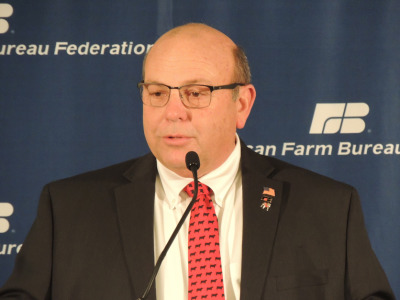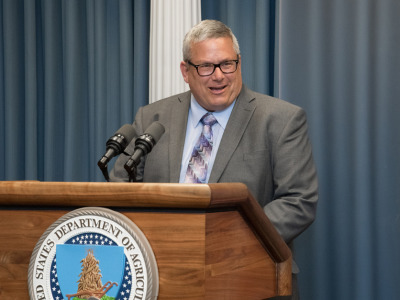EPA and the Army Corps of Engineers announced their new “waters of the U.S.” proposal Tuesday at an event that attracted dozens of farmers and industry leaders who had long sought straightforward definitions that allowed farmers to more clearly decide how to operate on their lands.
Representatives of all 50 state farm bureaus were at EPA headquarters, along with leaders of numerous other national farm groups and 20 farm-state lawmakers, to welcome the proposal, which EPA Acting Administrator Andrew Wheeler said is designed to help landowners easily determine which areas of their property are covered by the federal Clean Water Act.
Farmers should be able to stand on their property and determine whether they have jurisdictional waters “without having to hire outside professionals,” Wheeler said.
The proposal would eliminate ephemeral streams – those created by rainfall and snowmelt – from federal jurisdiction, and tighten guidelines for when other streams and wetlands would be considered for potential regulation.
“This is fabulous,” Agricultural Retailers Association CEO Daren Coppock said after the 90-minute rollout. “These are answers we’ve needed for a long time, so this is a great step.”
Kevin Kester, president of the National Cattlemen’s Beef Association, also praised the proposal. “This is a historic day, very eventful,” he said. “Under the 2015 rule, 100 percent of our ranch would fall under the jurisdiction of WOTUS. Under the new rule, zero acres will be under jurisdiction.”
American Farm Bureau President Zippy Duvall addressed the crowd, saying farmers want to be able to identify from their pickups whether their land has jurisdictional waters. “They just want the right to do what’s best for them,” he said.

Farm Bureau President Zippy Duvall
And if there were any doubt about how the agriculture sector felt about the proposal, Senate Agriculture Committee Chairman Pat Roberts, R-Kan., laid it to rest with his comments. “For too long now EPA has been a four-letter word out in farm country,” Roberts said. “Now it is a four-letter word: The Environmental Farm Protection Agency.”
Environmental groups and Democratic lawmakers, who were absent at EPA, said the proposal increases the amount of streams and wetlands nationwide that would now be vulnerable to development or farming without a permit.
“They put politics over public health,” Sen. Ben Cardin, D-Md., said on a call organized by environmental groups. In Maryland, he said, “64 percent of our drinking water comes from small streams” that would be in jeopardy under Tuesday's proposal.
Rep. Peter DeFazio, D-Ore., vowed as the next chairman of the House Transportation and Infrastructure Committee, he would hold “extensive oversight hearings” on the proposal.
The Theodore Roosevelt Conservation Partnership said if the proposal became law, “adjacent wetlands will only receive protection if they are physically connected to other jurisdictional waters. This disregards the EPA’s own research that shows wetlands and ephemeral and intermittent streams, even those that lack surface connection, provide important biological and chemical functions that affect downstream waters.”
The result would “leave important habitat for fish and waterfowl vulnerable to pollution and destruction,” TRCP said.
“No matter which party holds the power in Washington, the needs of America’s hunters and anglers have not changed since we supported the 2015 Clean Water Rule – all streams and wetlands are crucial to supporting healthy fish and waterfowl populations that power our sports, and an entire swath of these important habitats does not deserve to be overlooked or written off on a technicality,” TRCP President and CEO Whit Fosburgh said in a news release.
Bill Northey, USDA undersecretary for farm production and conservation, told Agri-Pulse after the event there is a “misconception” that the Clean Water Act is the only law protecting wetlands and water use. There are also protections under the so-called "Swampbuster" provisions and state laws, he said.
Northey said most of the controversy over how wetlands are regulated under the 2015 WOTUS rule “has been around those areas that have been not clear wetlands or have been very occasionally damp.” The EPA/Corps proposal is “attempting to sort out those – trying to make sure we have wetlands that folks value.”

Bill Northey, USDA
Speakers at the EPA event frequently jabbed the Obama administration for attempting a “power grab” with the 2015 rule. Interior Secretary Ryan Zinke said flatly, “Decisions about water should be left to the local community and the state.”
Rep. Greg Walden, R-Ore., said waters not covered by the federal rule could be regulated by states or tribes.
Among specific provisions of interest to agriculture are the exclusion of ditches from federal jurisdiction unless they contribute flow to a “water of the U.S.” as determined by EPA or the Corps. The proposal also would exclude farm ponds, log cleaning ponds, and cooling ponds.
The proposal would continue to exclude prior converted cropland from the WOTUS definition. In the proposal, EPA and the Corps say they would consider prior converted cropland to be abandoned “if it is not used for, or in support of, agricultural purposes at least once in the immediately preceding five years. Agricultural purposes include land use that makes the production of an agricultural product possible, including but not limited to grazing and haying.”
The proposed rule also would clarify that “cropland that is left idle or fallow for conservation or agricultural purposes for any period of time remains in agricultural use, and therefore maintains the prior converted cropland exclusion.”
The proposed rule is subject to a 60-day public comment period, which begins once it is published in the Federal Register. Afterward, EPA and the Corps are expected to publish a final rule, which is almost certain to be challenged in court.
For more news, go to www.Agri-Pulse.com


